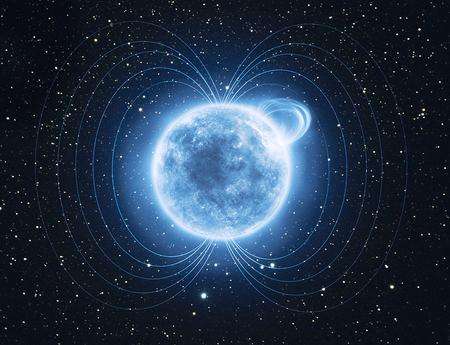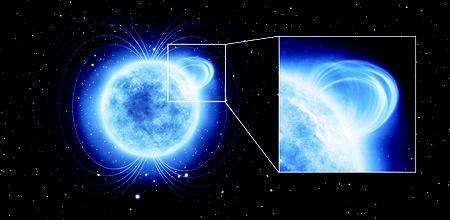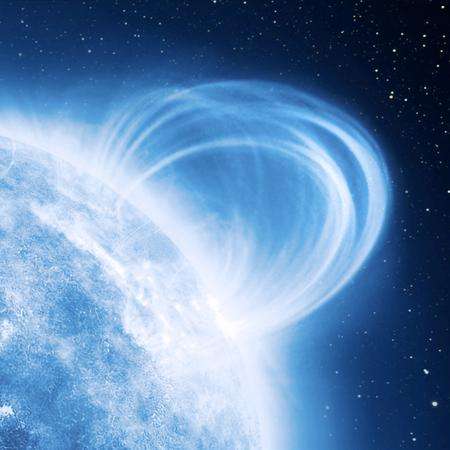Mysterious magnetar boasts one of strongest magnetic fields in Universe

(Phys.org) —A team of astronomers including two researchers from UCL's Mullard Space Science Laboratory has made the first ever measurement of the magnetic field at a specific spot on the surface of a magnetar. Magnetars are a type of neutron star, the dense and compact core of a giant star which has blasted away its outer layers in a supernova explosion.
Magnetars have among the strongest magnetic fields in the Universe. Until now, only their large scale magnetic field had been measured. However, using a new technique and observations of a magnetar in X-rays, the astronomers have now revealed a strong, localised surface magnetic field on one.
Magnetars are very puzzling neutron stars. Astronomers discovered them through their unusual behaviour when observed in X-ray wavelengths, including sudden outbursts of radiation and occasional giant flares. These peculiar features of magnetars are caused by the evolution, dissipation and decay of their super-strong magnetic fields, which are hundreds or thousands of times more intense than those of the more common type of neutron stars, the radio pulsars.
The magnetic field of a magnetar can have a complex structure. The most obvious, and easy-to-measure, component is the large scale external magnetic field, which is shaped (and behaves) much like a regular bar magnet's. This is known as the dipolar field.
The study was carried out on a magnetar called SGR 0418+5729. A few years ago, this star was discovered to have a relatively gentle dipolar magnetic field compared to other magnetars. However, the star was showing the typical flaring and bursting activities seen in other magnetars, leading scientists to suggest that the star's magnetic activity might be caused by a field hidden beneath its surface.

This new study, based on observations from ESA's XMM-Newton X-ray space telescope, has finally found evidence that SGR 0418+5729 is indeed concealing a very strong magnetic field in its interior.
"This magnetar has a strong magnetic field inside it, but it is hidden beneath the surface. The only way you can detect that is to find a flaw on the surface, where the concealed magnetic field can leak out," says Silvia Zane (UCL Mullard Space Science Laboratory), one of the co-authors of the study.
Such magnetic leaks would also explain the outbursts and flares of radiation observed from magnetars. The warped magnetic field trapped inside the star builds up stress below the magnetar's surface, occasionally breaking its 'crust' apart and releasing sudden flashes of X-rays.
Magnetars are far too small – only around 20km across – and distant for even the best telescopes to see any details on their surfaces. They appear just as dots of light in astronomers' observations. So the team had to look for indirect signs of variation on SGR 0418+5729's surface. To do this, they measured how the magnetar's X-ray emissions varied as the star rotates.
"SGR 0418+5729 rotates once every 9 seconds. We found that at one point during the rotation, the magnetar's X-ray brightness drops sharply. That means something on or near one part of the surface is absorbing the radiation," adds Roberto Turolla (an honorary professor at MSSL and co-author of the study).

The team believes that a concentration of protons over a small area of the magentar's surface – perhaps as little as a few hundred metres across – is absorbing the X-rays. The protons are confined to a small volume near the surface by a strong, localised magnetic field emerging from the magnetar's interior, giving powerful evidence that a strong and twisted internal magnetic field lurks beneath the surface.
"This exciting discovery also confirms that, in principle, other pulsars with relatively low external magnetic fields might conceal a similar strong magnetic field in the interior. As a result, many pulsars may switch on and become active flaring magnetars for a while, so in the future we may discover much more magnetars than what we previously thought. This call for a major revision of our current ideas of magnetic field formation and amplification in neutron stars," explains Zane.
The study is published in the journal Nature.
More information: "A variable absorption feature in the X-ray spectrum of a magnetar," by A. Tiengo et al is published in Nature, 15 August 2013.
Journal information: Nature
Provided by University College London



















